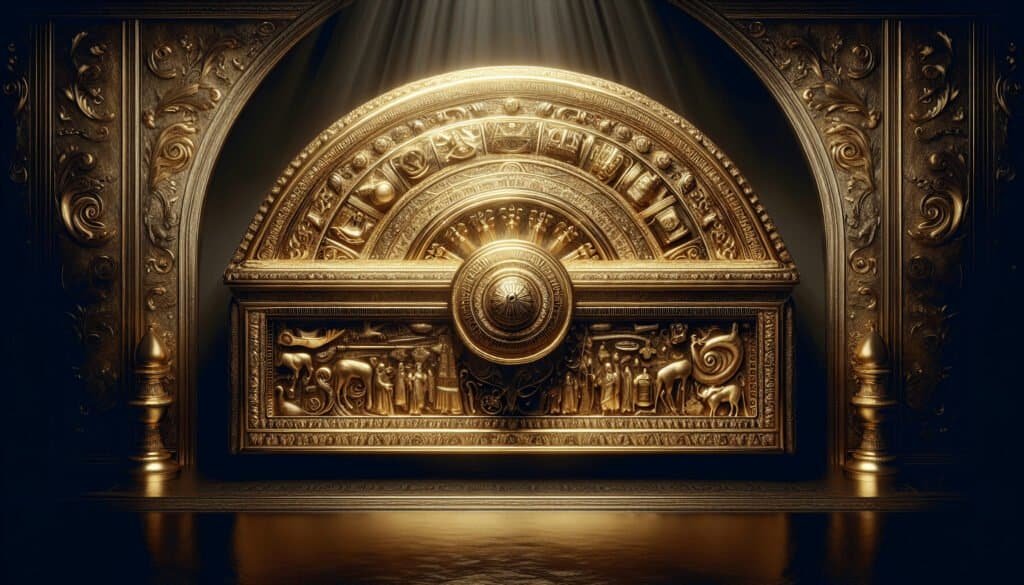What if the stories you’ve heard about the Golden Ark Lid aren’t just fantastical tales but whispers of a profound truth buried within the sands of time? The legends surrounding this ancient artifact stir a sense of curiosity and reverence across cultures and generations. Let’s sift through the dust of history, archaeology, and theology to unravel the enchanting mysteries that this golden treasure holds.
The Ark of the Covenant: A Glimpse into Sacred History
No discussion of the Golden Ark Lid can start without acknowledging the Ark of the Covenant itself, a biblical artifact laden with significance. According to the Book of Exodus, this magnificent chest was constructed by the Israelites under Moses’ command. Built of acacia wood and overlaid with gold, the Ark housed the tablets of the Ten Commandments, the manna from the desert, and Aaron’s staff.
A Symbol of Divine Presence
For the ancient Israelites, the Ark was more than a mere container. It was viewed as the embodiment of God’s presence among His people—an assurance during daunting times, a guiding light in their wanderings. Its construction was meticulous; the specifications were provided directly by God, emphasizing its divine origin.
- Biblical References:
- Exodus 25:10-22 details the Ark’s design.
- Leviticus 16:2 explains its role in the atonement rituals.
The ancient texts describe the Ark as having a lid called the “Mercy Seat,” intricately designed with two cherubim facing each other. This wasn’t merely decorative; it was symbolic of God’s glory and the divine connection to humanity.
The Golden Ark Lid: A Masterpiece of Craftsmanship
When you picture the Golden Ark Lid, think of art and spirituality intertwined. Its gold surface gleamed, capturing light in a way that seemed otherworldly.
Crafting the Lid
The lid is crafted from pure gold and spans about 2.5 cubits in length and 1.5 cubits in width. It wasn’t just a lid; it served as the specific place where God was said to meet Moses.
- Cherubim: The two golden cherubim were not merely ornamental; they were representations of angelic beings. With wings spread, they formed a throne-like presence, signifying the space where the divine mercy would descend.
This lid’s artwork and craftsmanship highlight the highly skilled artisans of the time. It was more than a personal expression; it was an offering intended to honor God and invite His perpetual presence.

Archaeological Insights: What Have We Found?
Many have sought the Ark of the Covenant throughout history, promising epic quests reminiscent of adventure novels. Yet, archaeological findings provide grounding in what we know versus what we dream.
Historical Context
Ancient Near Eastern culture, particularly the Canaanite and Egyptian societies, heavily influenced the construction of the Ark and its Lid. Archaeological evidence reflects that similar items were created in surrounding cultures but often lacked the spiritual resonance that the Ark possessed.
- Excavations at Various Sites:
- Sites such as Jericho and Ai have hinted at the potential presence of biblical artifacts, although none have been conclusively identified as the Ark.
The Quest for the Ark: False Leads
Throughout history, numerous claims have emerged regarding the Ark’s whereabouts, from hidden caverns of Ethiopia to vaults beneath the Temple Mount in Jerusalem. However, most of these claims remain speculative at best.
| Quest Location | Claim | Status |
|---|---|---|
| Ethiopia | Claims of the Ark being in the Church of St. Mary of Zion | Highly debated |
| Jerusalem | Speculations of the Temple Mount housing the Ark | Subject to mythology |
| Mount Nebo | Suggested resting place after Moses’ death | No evidence found |
These pursuits underline a pervasive phenomenon; the quest for the Golden Ark Lid symbolizes a human yearning for connection with the divine—a treasure sought not just for material wealth, but for spiritual fulfillment.
Theological Significance: What Does the Lid Represent?
Religious scholars and theologians often delve into the implications of the Golden Ark Lid, interpreting its meanings on multiple levels.
The Mercy Seat and Atonement
One of the most profound aspects of the Golden Ark Lid is its role as the Mercy Seat, the designated place for atonement. Historically, during Yom Kippur—the Day of Atonement—sacrifices were made, and the blood of sacrificial animals was sprinkled on the Mercy Seat.
- Spiritual Reflection: This act symbolizes the covering of sins and the re-establishment of a covenantal relationship with God. It’s a tangible connection between human shortcomings and divine grace.
Transcending Time and Culture
The legacy of the Ark and its Lid extends beyond Judaism into Christian theology. For many, the Mercy Seat represents Christ’s redemptive sacrifice, a reflection on how the Old Testament prefigures New Testament events.
- Scriptural Correlation:
- Hebrews 9:5 refers to the Ark and acknowledges its enduring significance.
Such interpretations enrich the narrative, offering layers of understanding that span millennia and cultures.

Cultural Impact: The Ark in Literature and Popular Culture
The Golden Ark Lid hasn’t merely existed in religious texts; it has inspired a vast array of cultural expressions. From literature to movies, the intrigue surrounding the Ark has captured imaginations far and wide.
In Literature and Film
You’ve likely seen references to the Ark in modern storytelling, whether in films like “Raiders of the Lost Ark” or Dan Brown’s novels. These interpretations breathe new life into ancient narratives, inviting audiences to connect with history through fictional lenses.
- Iconography of the Ark in Media:
- Symbols of mystery and adventure often accompany the visual representations of the Ark, contributing to its mythical status.
Cultural Legacy
Beyond entertainment, the Ark also embodies ideals of purity, obedience, and hope. Across various cultures, stories of the Ark and the Golden Lid signify a pursuit of righteousness and justice.
| Medium | Representation |
|---|---|
| Films | Often depict the artifact as a source of immense power |
| Literature | Explores moral and philosophical themes tied to divine connection |
| Art | Visuals often highlight its opulence and spiritual symbolism |
The Golden Ark Lid transcends its material origins, affirming its role as a cultural touchstone that resonates in our collective consciousness.
Modern Perspectives: The Ark’s Influence on Spirituality Today
As you consider the Golden Ark Lid, it’s worth examining how its legacy influences spiritual practices and beliefs in contemporary society.
Relevancy in Modern Faith
Many faith communities continue to emphasize the Ark’s symbolism of divine guidance and mercy as a source of comfort and hope. The idea that God dwells among His people still holds significance in church teachings.
- Spiritual Rituals: Ceremonies commemorating the Ark signify community, remembrance, and the pursuit of a deeper connection with the divine.
The Quest for Authenticity
In a world hungry for authenticity, the allure of the Ark and its Lid acts as a reminder of humanity’s quest for purpose. In many ways, you might find parallels between the ancient desires for connection and modern pursuits of meaning.
- Personal Reflection: Engaging with stories of the Ark can encourage introspection regarding your beliefs and values, leading to a richer understanding of your own spiritual journey.
Summary: Tying Ancient Narratives to Modern Significance
The Golden Ark Lid stands not only as an artifact of golden splendor but as a vessel of profound spiritual truths. It invites you to reflect on themes of mercy, connection, and the unquenchable human thirst for the divine.
As we’ve journeyed through history, archaeology, and theology, you’ve likely noticed the myriad ways the stories surrounding the Ark and its Lid reach into our present lives. They resonate in modern faith practices, cultural expressions, and personal quests for meaning.
In understanding the legends of unseen glory, you may just find your own place within these tales, as the quest for the sacred continues—one story, one truth at a time.



